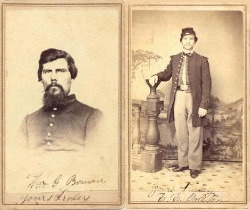The daguerreotype was invented by Louis-Jacques-Mande Daguerre in 1839 in France. The daguerreotype the first photographic process and became popular in 1839, but was replaced by the camera obscura, which was less expensive. The surface of the daguerrotype resembled a mirror.

2. What is an "albumen" print? What was the main "ingredient" of the albumen process? When did the albumen process die out?
The albumen print is a photographic process that was created in the 1850s . During the process, a piece of paper is dipped in a misture of salt, water, and egg whites and then coated with silver nitrate when after it dries. The process died out in the 1890s.
3. What is a "stereograph?" When were they popular?
The steroegraph is an early early form of three-dimensional photography and was popular in the nineteenth century. It began with two two-dimensional photos that were combined to make a three-dimensional image.
4. What is a "carte de visite?" What were they used for?
A carte de visite is a small photograph that was invented in France in 1854. They were usually made from a albumen print that was mounted on thicker paper. The carte de visites were used as potcards and were popular until 1859.

5. Who were Matthew Brady and Alexander Gardner? They both are notable for what type of photography? When were they active? Post two noteworthy photographs for each photographer.
Matthew Brady- Matthew Brady was was one of the most popular nineteenth century photographers. He made photographs using the daguerreotype, and he won many awards for his work.
Alexander Gardner- Alexander is famous for his photography work during the Civil War. A lot of his work was done with the stereograph. He travelled and took photos during different battles and developed his photos in his travelling dark room. He also took a lot of portraits.



